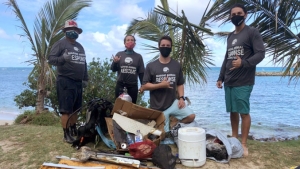
To address the devastating impacts of marine debris in the coastal environment, one of the leading causes of injury and death for sea turtles, seabirds and Hawaiian monk seals, the University of Hawaiʻi Sea Grant College Program (Hawaiʻi Sea Grant) and Hawaiʻi Marine Animal Response (HMAR), the largest Hawaiʻi-based marine species response and conservation nonprofit organization, received $50,000 from NOAA Sea Grant and the NOAA Marine Debris Program. This grant is matched by $50,000 from non-federal sources.
The funding is one of six new, creative projects to tackle marine debris challenges across the country awarded to Sea Grant programs in Hawaiʻi, Florida, Georgia, Illinois-Indiana, Puerto Rico and Wisconsin. These marine debris projects total $300,000 in federal funding and are matched by non-federal contributions, bringing the total investment to approximately $600,000.

“By preventing marine debris, we can reduce the impacts of this global problem,” stated NOAA Marine Debris Program Director Nancy Wallace. “We are pleased to partner with NOAA Sea Grant to provide support for projects that will help stop trash and fishing gear at their source.”
Reaching the community
In Hawaiʻi, HMAR’s multipart project incorporates shore-based and underwater marine debris collection, community outreach, school education, and a statewide citizen-science project called “Beat Debris,” which encourages recreational divers to safely remove marine debris and recreational fishing gear, and to report the materials collected so that the data can be collated and analyzed.
“HMAR is excited about the opportunity to partner with the Hawaiʻi Sea Grant Program and honored to have been awarded this highly competitive grant. Marine debris poses a large and pervasive threat to protected marine species including sea turtles, seabirds and Hawaiian monk seals, as well as other parts of our shared ocean ecosystem such as coral reefs,” said Jon Gelman, the president of HMAR.
Marine debris can include everyday trash such as plastic bags, cigarette butts, foam take-out containers and balloons that end up in the marine environment. It can also range greatly in size from small pieces of plastic that can’t be seen with the human eye, to large derelict fishing nets and abandoned and derelict vessels. These items become marine debris as a result of littering, dumping, ineffective or improper waste management, and disasters, and can have many adverse effects on wildlife, the environment and coastal communities. Importantly, lost or abandoned recreational fishing debris such as monofilament fishing line, hooks, lures, weights, traps and nets cause a significant number of injuries and deaths to protected marine animals in Hawaiʻi’s near-shore ocean environment.
To help align the projects with the NOAA Marine Debris Program’s Strategic Plan and Regional Marine Debris Action Plans, the Marine Debris Program’s regional coordinators will collaborate with project leaders throughout the award period. The project activities begin this summer and will continue for up to two years.
This effort is an example of UH Mānoa’s goal of Excellence in Research: Advancing the Research and Creative Work Enterprise (PDF), Building a Sustainable and Resilient Campus Environment: Within the Global Sustainability and Climate Resilience Movement (PDF) and Enhancing Student Success (PDF), three of four goals identified in the 2015–25 Strategic Plan (PDF), updated in December 2020.
For more information, see Hawaiʻi Sea Grant’s website.
–By Cindy Knapman

